15 Best Pollinator-Friendly Container Plants for Patios and Balconies
Did you know that over 75% of flowering plants rely on pollinators for reproduction? That’s right! As urban dwellers, we have a crucial role in supporting these tiny ecosystem heroes. Let’s transform our patios and balconies into buzzing havens for bees, butterflies, and hummingbirds! In this guide, we’ll explore the 15 best pollinator-friendly container plants that’ll turn your outdoor space into a vibrant oasis. Ready to make a difference? Let’s dive in!
Why Choose Pollinator-Friendly Container Plants?
You know, I never really gave much thought to pollinators until a few years back when I noticed my tomato plants weren’t producing fruit. It was a real head-scratcher! After some digging (pun intended), I realized it was because there weren’t enough pollinators visiting my balcony garden. That’s when it hit me – we urban folks need to step up our game!
Choosing pollinator-friendly container plants isn’t just about having a pretty balcony (though that’s definitely a perk). It’s about supporting our local ecosystems and biodiversity. Think about it – by planting a few flowers, we’re essentially creating mini-sanctuaries for bees, butterflies, and other beneficial insects right in the heart of the city!
Now, I’m no environmental scientist, but I’ve learned that these little gardens can make a big difference. They enhance our urban green spaces, providing food sources for insects and birds that might otherwise struggle in concrete jungles. Plus, let’s be honest, who doesn’t love seeing a butterfly flutter by while you’re sipping your morning coffee?
But here’s the kicker – these plants don’t just benefit the critters. They add beauty and color to your outdoor living area too! I remember the first time I saw a hummingbird hovering around my newly planted salvia. It was like watching a tiny, iridescent helicopter! That moment alone made all the effort worthwhile.
And get this – by choosing pollinator-friendly plants, we’re actually contributing to sustainable gardening practices. It’s like we’re part of this big, global effort to keep our planet healthy. How cool is that? It’s like being an eco-warrior, but instead of a sword, you’re wielding a watering can!
Now, I gotta admit, when I first started, I made some rookie mistakes. Like the time I thought more flowers meant more pollinators, so I crammed about a dozen different plants into one tiny container. Let’s just say it didn’t end well for anyone involved – plants or pollinators! But hey, live and learn, right?
The point is, choosing pollinator-friendly container plants is a win-win situation. You get a beautiful outdoor space, and you’re doing your bit for the environment. And trust me, once you see your first bee buzzing happily around your balcony, you’ll be hooked!
Top 5 Container Plants for Attracting Bees
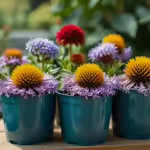 Alright, let’s talk about our buzzy little friends – the bees! Now, I used to be one of those people who’d run screaming at the sight of a bee. But after I started my pollinator garden? Well, let’s just say I’ve become quite the bee enthusiast!
Alright, let’s talk about our buzzy little friends – the bees! Now, I used to be one of those people who’d run screaming at the sight of a bee. But after I started my pollinator garden? Well, let’s just say I’ve become quite the bee enthusiast!
- First up on our list is lavender. Oh man, the smell of lavender on a warm summer day is just heavenly! It’s like aromatherapy for your balcony. Bees absolutely love it, and it’s perfect for those sunny spots that get a bit too hot for other plants. Plus, it’s pretty drought-tolerant, which is great for those of us who occasionally forget to water (guilty as charged!).
- Next, we’ve got borage. Now, I’ll be honest, when I first heard about borage, I thought it was some kind of medieval weapon. Turns out, it’s this amazing plant with these cute little star-shaped blue flowers. Bees go crazy for it! And get this – the flowers are edible and taste a bit like cucumber. How’s that for a conversation starter at your next barbecue?
- Third on our list is calendula. These cheerful orange blooms are like little suns in your container garden. They’re super easy to grow, which is great for us brown-thumb gardeners. I remember planting some seeds, forgetting about them, and then BAM! A couple of weeks later, I had these gorgeous orange flowers. The bees were having a field day!
- Now, here’s a fun one – basil! Yep, the same basil you use in your pasta sauce. Talk about a multi-tasker! It’s great for attracting bees, and you can snip off a few leaves for your cooking. I once made the mistake of harvesting all my basil at once, thinking I’d make a big batch of pesto. Let’s just say the bees were not impressed with my bare stems. Lesson learned: always leave some for the pollinators!
- Last but not least, we’ve got catmint. This is a long-blooming perennial with these gorgeous purple flowers. The bees absolutely adore it, and bonus – it’s pretty low maintenance. Just a word of warning though – if you have a cat, they might love it a bit too much. I once caught my neighbor’s cat rolling around in my catmint like it was catnip. It was hilarious, but not great for the plant!
Now, here’s a pro tip I learned the hard way – don’t plant all of these in the same container. I tried that once, thinking I’d create some sort of bee paradise. Instead, I ended up with a overcrowded mess where nothing thrived. Give each plant its own space, and they’ll reward you (and the bees) with plenty of blooms.
Remember, bees are essential pollinators. Without them, we’d be in a world of trouble when it comes to our food supply. So by planting these bee-friendly container plants, you’re not just prettying up your balcony – you’re doing your part to help these important little critters. And trust me, there’s something really special about watching a bee happily buzz from flower to flower in a garden you created. It’s like you’re part of this big, beautiful ecosystem. How cool is that?
Best Container Plants for Butterflies
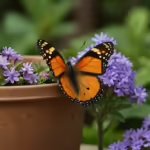 Alright, folks, let’s flutter on over to the world of butterfly-friendly container plants! Now, I gotta tell ya, the day I saw my first butterfly land on my balcony garden, I felt like a kid again. It was like magic right there in the middle of the city!
Alright, folks, let’s flutter on over to the world of butterfly-friendly container plants! Now, I gotta tell ya, the day I saw my first butterfly land on my balcony garden, I felt like a kid again. It was like magic right there in the middle of the city!
- First up on our butterfly hit list is the aptly named Butterfly Bush. Don’t let the name fool you though – I once bought a full-sized one without realizing how big it could get. My poor balcony looked like a jungle! Thankfully, there are compact varieties that are perfect for container gardens. These beauties produce clusters of flowers that butterflies just can’t resist. It’s like a butterfly buffet!
- Next, we’ve got Lantana. Oh boy, if you want a heat-loving plant that’ll give you blooms all summer long, this is your guy. I remember planting some during a particularly scorching summer, thinking I’d killed it for sure. But nope! It thrived and attracted so many butterflies, I started calling my balcony “Butterfly Central”.
- Now, let’s talk about Zinnias. These are my go-to when I want a pop of color and a bunch of butterflies. They’re super easy to grow – I’m talking “forget to water them for a week and they still survive” easy. Plus, they come in so many vibrant colors, it’s like having a rainbow in your container. Just be prepared for some serious butterfly action!
- Fourth on our list is the Coneflower, or Echinacea if you’re feeling fancy. These are great for those of us who sometimes forget we have plants (guilty as charged). They’re drought-tolerant and produce these gorgeous, daisy-like flowers that butterflies love. Plus, they bloom for ages. I once had a coneflower that kept blooming well into fall – talk about getting your money’s worth!
- Last but not least, we’ve got Salvia. Now, this plant is a real overachiever. Not only does it attract butterflies, but it’s also a hit with hummingbirds. I planted some red salvia last year, and I swear, it was like Grand Central Station for pollinators. The spiky flowers are just irresistible to them. Just a word of warning though – don’t plant it too close to your outdoor seating unless you want to feel like you’re in the middle of a nature documentary every time you try to relax!
Here’s a little trick I learned – try planting a mix of these in a large container. I did this once, thinking I was being clever by saving space. Turns out, I accidentally created a butterfly paradise! The different colors and flower shapes seemed to attract even more butterflies than when I had them in separate pots.
One thing to keep in mind – butterflies like a bit of shelter too. I learned this the hard way when I saw butterflies struggling to land on my plants during a windy day. Now I make sure to include some taller plants or even a small decorative trellis in my container garden to give them something to cling to.
And hey, don’t forget to enjoy the show! There’s something really special about seeing a butterfly float by and land on a flower you planted. It’s like you’re contributing to this beautiful, delicate ecosystem right there on your balcony or patio. So grab a cup of coffee, sit back, and watch the butterfly ballet. Trust me, it’s better than anything on TV!
Hummingbird-Friendly Container Plants
Alright, folks, let’s zoom in on some hummingbird-friendly plants! Now, I gotta tell ya, the first time I saw a hummingbird on my balcony, I thought I was hallucinating. These tiny, iridescent speed demons are absolutely mesmerizing!
 First up on our hummingbird hit parade is the fabulous Fuchsia. These plants are like nature’s chandeliers, with their pendulous, jewel-toned flowers. They’re perfect for hanging baskets, which is great because it puts those nectar-filled blooms right at hummingbird eye level. I once had a fuchsia that got so big, I swear it was trying to take over my entire balcony! But man, the hummingbirds loved it.
First up on our hummingbird hit parade is the fabulous Fuchsia. These plants are like nature’s chandeliers, with their pendulous, jewel-toned flowers. They’re perfect for hanging baskets, which is great because it puts those nectar-filled blooms right at hummingbird eye level. I once had a fuchsia that got so big, I swear it was trying to take over my entire balcony! But man, the hummingbirds loved it.- Next, we’ve got Bee Balm. Don’t let the name fool you – this plant is a hummingbird magnet! With its showy, spiky flowers, it looks like something out of a Dr. Seuss book. And bonus: it also attracts bees and butterflies. Talk about a multi-tasker! Just a word of caution though – it can spread like crazy if you’re not careful. I once planted some in a container with other flowers, and before I knew it, it had muscled out everything else!
- Third on our list is the Cardinal Flower. Now, if you want to see hummingbirds go absolutely bonkers, plant some of these bad boys. The bright red flowers are like hummingbird catnip! I remember the day I planted mine – within hours, I had my first hummingbird visitor. It was like they had a secret hummingbird hotline or something!
- Moving on to Penstemon. These plants produce these cool, tubular flowers in various colors. It’s like having a buffet of nectar straws for hummingbirds! I’ve found that planting different colors in the same container creates this awesome, colorful display that hummingbirds just can’t resist. Plus, it makes your balcony look like a living rainbow!
- Last but not least, we’ve got the classic Petunia. Now, I used to think petunias were kinda boring – until I saw a hummingbird dive-bombing my petunia hanging basket! Those trumpet-shaped blooms are perfect for hummingbird beaks. And let me tell you, watching a tiny hummingbird navigate a big petunia flower is like watching an aerial acrobatics show.
Here’s a little tip I learned through trial and error: hummingbirds seem to prefer red flowers, but they’ll visit any color. I once had a mix of red and purple petunias, and while the red ones were definitely the favorite, the purple ones got plenty of action too.
Oh, and here’s something I found out the hard way – hummingbirds can be territorial little suckers! I once had two hummingbirds get into a mid-air standoff over my cardinal flower. It was like watching a mini dogfight! So if you really want to keep the peace, try spreading your hummingbird-friendly plants out a bit.
And hey, don’t forget to enjoy the show! There’s something magical about seeing these tiny, flying jewels zipping around your balcony or patio. It’s like having your own private National Geographic special right outside your window. So grab a comfy chair, pour yourself a cool drink, and prepare to be amazed. Just don’t be surprised if you find yourself talking to the hummingbirds – I may or may not have named the regulars that visit my balcony. No judgment here!
Tips for Creating a Pollinator-Friendly Container Garden
Alright, green thumbs and garden newbies alike, let’s dive into some tips for creating your very own pollinator paradise in containers! Trust me, I’ve made every mistake in the book, so learn from my blunders and save yourself some heartache (and dead plants).
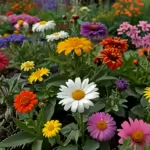 First things first, variety is the spice of life – and that goes double for pollinator gardens! You want to choose a variety of plants with different bloom times. I learned this the hard way when I planted all my flowers at once and had a spectacular show for about two weeks… followed by months of green leaves and disappointed pollinators. Now I make sure to have early, mid, and late bloomers so there’s always something in flower.
First things first, variety is the spice of life – and that goes double for pollinator gardens! You want to choose a variety of plants with different bloom times. I learned this the hard way when I planted all my flowers at once and had a spectacular show for about two weeks… followed by months of green leaves and disappointed pollinators. Now I make sure to have early, mid, and late bloomers so there’s always something in flower.- Next up, don’t forget to provide a water source for your pollinator pals! I once saw a bee trying to drink from my neighbor’s dripping air conditioner – talk about desperate times! A shallow dish with some pebbles for landing pads works great. Just make sure to change the water regularly, unless you want to start a mosquito farm instead!
- Here’s a biggie – avoid using pesticides in your container garden. I know it’s tempting when you see a few aphids, but trust me, it’s not worth it. I once sprayed some “eco-friendly” pesticide on my plants and ended up with a ghost town of a garden. No bugs, sure, but also no bees, no butterflies, no nothin’. Now I just squish the aphids with my fingers. It’s gross, but effective!
- Grouping your containers together isn’t just aesthetically pleasing – it’s also more attractive to pollinators. It’s like creating a little oasis in the concrete jungle. I started with just one lonely pot on my balcony and wondered why I never saw any butterflies. Once I added a few more and grouped them together? Bam! Pollinator party central!
- Last but definitely not least, make sure your containers have proper drainage and that you’re watering regularly. I once thought I was being clever by using an old bucket as a planter. Let’s just say that after a week of rain, my “clever” idea turned into a swamp. Now I make sure all my containers have drainage holes and I check the soil moisture regularly.
Oh, and here’s a bonus tip I picked up along the way – consider the “thriller, filler, spiller” approach when planting your containers. That’s a tall plant in the center (thriller), bushy plants around it (filler), and trailing plants around the edges (spiller). It creates this gorgeous, layered look that’s not only pretty but gives pollinators lots of options!
Remember, creating a pollinator-friendly container garden is as much about the journey as it is about the destination. Don’t be afraid to experiment, and don’t beat yourself up if something doesn’t work out. Heck, half the fun is in the learning! And trust me, the first time you see a butterfly land on a flower you grew, or watch a bee buzzing happily from bloom to bloom, you’ll be hooked. Happy gardening, folks!
Conclusion
Well, folks, we’ve buzzed through quite the pollinator adventure, haven’t we? From bee-utiful blooms to butterfly buffets and hummingbird havens, we’ve covered it all. And let me tell you, creating a pollinator-friendly container garden isn’t just good for our little winged friends – it’s a total game-changer for us urban dwellers too!
Remember, every flower counts when it comes to supporting our buzzing buddies. Whether you’ve got a sprawling patio or just a tiny balcony, there’s always room for a pot or two of pollinator-friendly plants. Heck, I started with just one sad little lavender plant, and now my balcony’s like a miniature ecosystem!
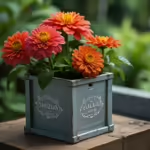 Now, don’t feel like you have to recreate the Amazon rainforest overnight. Start small, experiment, and see what works for you and your space. Maybe those Zinnias will be a hit, or perhaps the Salvias will steal the show. The beauty of container gardening is that if something doesn’t work out, you can always move it or try something new next season.
Now, don’t feel like you have to recreate the Amazon rainforest overnight. Start small, experiment, and see what works for you and your space. Maybe those Zinnias will be a hit, or perhaps the Salvias will steal the show. The beauty of container gardening is that if something doesn’t work out, you can always move it or try something new next season.
And hey, while you’re at it, why not get your neighbors involved? I once started a friendly competition with my next-door neighbor to see who could attract the most butterflies. Before we knew it, our whole floor was buzzing with pollinator activity! It’s amazing how a few plants can bring a community together.
Just remember to keep it safe and ethical. No pesticides, please! And if you’re planting anything that might be toxic to pets or kids, make sure to keep it out of reach. We want to create a paradise, not a hazard zone!
So, what are you waiting for? Grab those gardening gloves, pick up some pots, and start planting! Your efforts will not only beautify your home but also contribute to a healthier planet. And trust me, there’s nothing quite like sipping your morning coffee while watching a hummingbird flit from flower to flower – all thanks to your green thumb!
Oh, and don’t forget to share your pollinator garden adventures in the comments below! Did you have any hilarious mishaps? Any unexpected visitors? Or maybe you’ve discovered the secret to growing the world’s most irresistible butterfly bush? We’re all ears! After all, gardening is more fun when we share our stories and learn from each other. Happy gardening, folks!
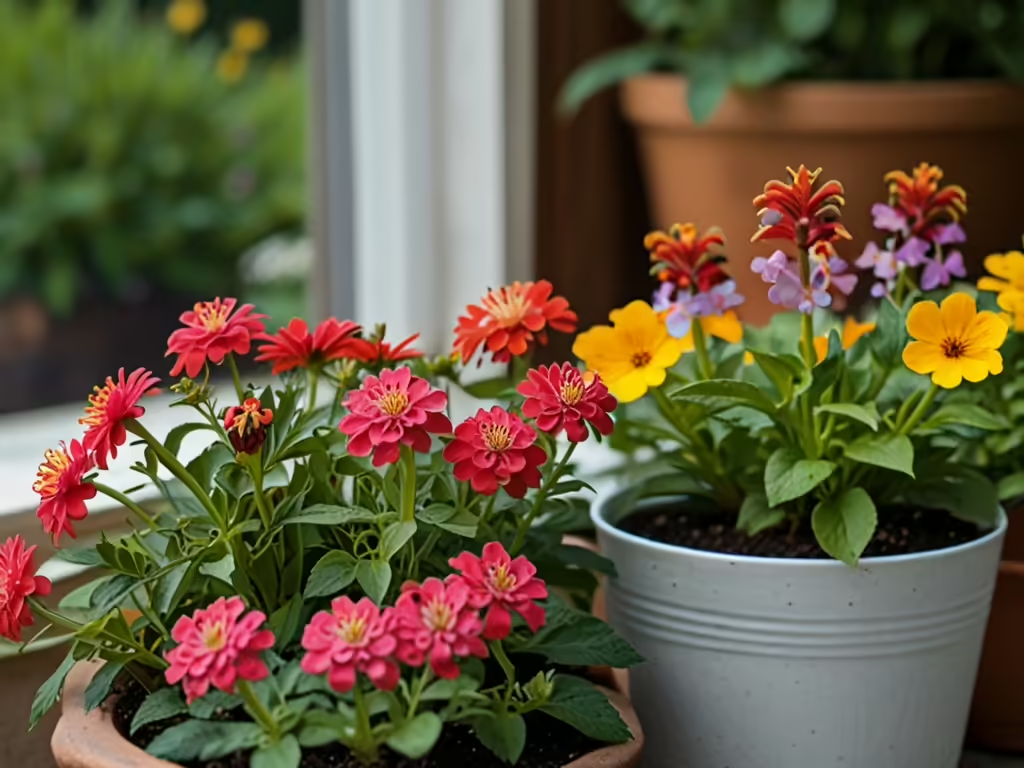



Post Comment